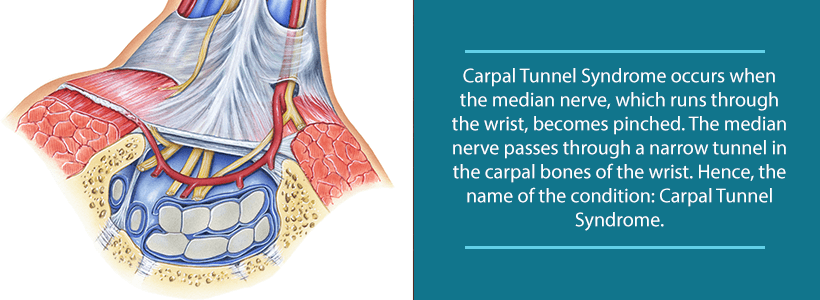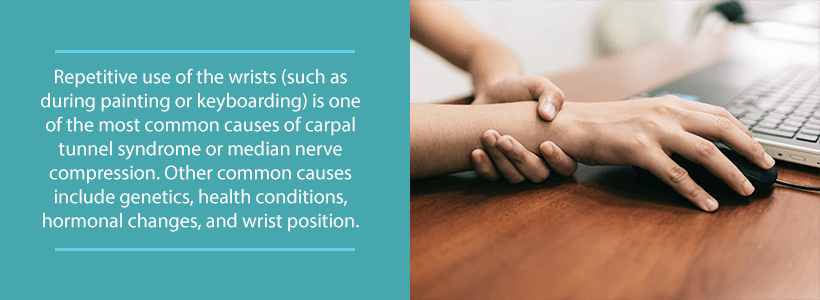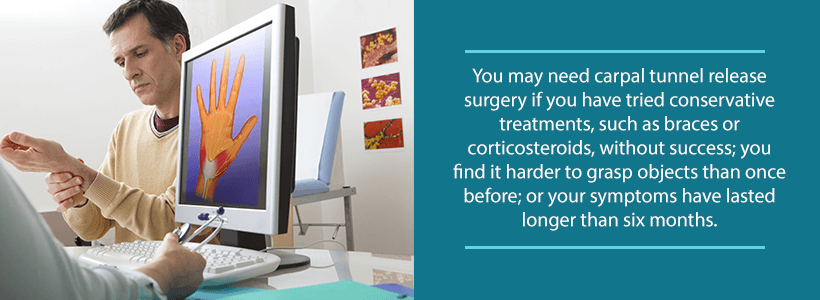What is Facet Nerve Ablation? Those who are seeking degenerative disc disease treatments have probably come across facet nerve ablation in their searches. But, is this an effective method of treating your degenerative disc disease…
Carpal tunnel syndrome (CTS), which leads to pain, numbness, and tingling in the hand and arm, is a frequent occurrence among office workers. CTS occurs when a component of wrist anatomy compresses the median nerve (a major nerve in the hand that innervates the wrist).
In the vast majority of cases, carpal tunnel syndrome symptoms only worsen with time. Therefore, it is always important to seek a diagnosis and treatment plan as soon as possible. In the early stages, symptoms may be alleviated through conservative measures such as wearing a wrist splint or avoiding certain intensive activities.
That being said, if pressure on the median nerve persists, it may lead to nerve damage—and as a result—exacerbated symptoms. To prevent permanent damage, it may be necessary for some patients to undergo surgery in order to relieve this pressure.

The Anatomy of the Wrist
The carpal tunnel is an inch wide passageway that travels through the wrist. This tunnel is formed by the meeting of small wrist bones that medical experts refer to as the carpal bones. The root of this tunnel is a strong series of connective tissues known as the transverse carpal ligament. These boundaries are very rigid, meaning that the carpal tunnel has little to no flexibility when it comes to increasing its size.
The median nerve headlines the show going on in the hand. It begins as a group of nerve roots in the neck, and these roots bunch together to form a single nerve in the arm. This nerve then travels down the arm and forearm, where it passes through the carpal tunnel located in the wrist and leading down to the hand. The median nerve provides us with feeling in our fingers, as well as control over the muscles surrounding the base of the thumb.
In addition, the nine tendons that bend the fingers and thumb also pass through the carpal tunnel. Medical experts refer to these tendons as flexor tendons.
What is Carpal Tunnel Syndrome (CTS)?
Carpal tunnel syndrome (CTS) occurs when the tunnel that contains the median nerve narrows or when the tissues surrounding the flexor tendons begin to swell. Medical experts refer to these tissues as the synovium, and they may cause pressure on the median nerve when they swell in size. Under normal circumstances, these tissues lubricate the tendons, which allows for greater flexibility in our fingers.
When the synovium swells in size and applies pressure to the median nerve, it leads to pain, tingling, numbness, and weakness in the hand. Most cases of CTS arise from a variety of different factors. Generally speaking, women and the elderly are more likely to develop the condition.
The following list includes other risk factors that may lead to CTS:
- Repetitive Use: Repetitive actions of the hand and wrist over a period of time will aggravate the tendons associated with CTS. This causes swelling, which applies pressure to the median nerve.
- Pregnancy: Changes in the body’s hormone levels during pregnancy may cause swelling that increases pressure on the median nerve.
- Heredity: Genetics may also cause the development of smaller carpal tunnels, which changes the amount of space available in the wrist for the median nerve.
- Health Conditions: Other conditions such as rheumatoid arthritis, thyroid gland imbalances, and diabetes may lead to CTS.
- Position: Hand and wrist positions also have a bearing on the development of CTS. Any activity that involves heavy flexion or extension of the hand or wrist over time will irritate the tendons in the wrist.

Carpal Tunnel Syndrome Symptoms
The following list includes common symptoms of carpal tunnel syndrome:
- Sporadic shock-like symptoms that radiate to the thumb, index, middle, and ring fingers.
- Numbness, tingling, and pain in the thumb, index, middle, and ring fingers.
- Pain may also travel up the forearm and into the shoulder
- Weakness in the hand
- Poor hand grip (You may frequently drop objects)
Most of the time, the symptoms of carpal tunnel syndrome begin slowly, and usually without an isolated injury or cause. Symptoms often come and go at first, but as CTS worsens, symptoms may arise more frequently and persist for much longer.
Symptoms at night time are also very common. Many people sleep with their wrists at an angle, and this may lead to insomnia in patients with CTS. During daytime hours, symptoms often occur while holding something for a long period of time with the wrist bent at an angle, such as while holding a coffee mug. Many patients will move or shake their hands to relieve symptoms during this time.
Do I Need Surgery for CTS?
Over time, CTS will weaken your hand and wrist muscles. If symptoms persist for a prolonged period of time, your condition will worsen and muscle damage may occur.
Your doctor may suggest surgery in the following situations:
- Conservative treatments, such as braces, corticosteroids, and physical therapy have not alleviated your symptoms.
- You find it progressively harder to grasp objects than you once did.
- Your symptoms have persisted without getting better for at least 6 months.
There are two types of procedures that doctors commonly use for carpal tunnel release surgery: open surgery and endoscopy. Either way, your doctor will cut ligaments around the carpal tunnel to release pressure from the median nerve. This, in turn, will help to relieve symptoms. After your doctor has completed the surgery, the ligament heals back together and also allows for more room surrounding the median nerve.
Open surgery involves a larger incision that may be as long as 2 inches, extending from the wrist to the palm. Endoscopic surgery works a little differently, by utilizing several smaller incisions and a tiny camera to help guide your surgeon through the procedure. This, of course, is a much easier procedure to heal from than open surgery. That being said, not all CTS cases are viable for endoscopic surgery. You will need to talk with your doctor to find out which procedure is best for your specific needs.

CTS Surgery: The Recovery Process
Some relief may occur on the same day as surgery, but the entire healing process takes a little bit longer than that. Patients should expect to experience pain and swelling immediately after their procedure. Your doctor will prescribe you medications that will alleviate any tenderness that you may experience. Soreness may last anywhere from a few weeks to a few months after your surgery.
Your wound dressing will stay on for at least 1-2 weeks, depending upon your case. During this time, your doctor will likely give you a list of appropriate exercises to perform in order to keep your fingers from becoming too stiff. That being said, you should still be careful to avoid too much strain while completing these exercises. Over time, you will be able to return to normal activities, such as driving, writing, and grabbing objects. This improvement typically becomes apparent by 6-8 weeks out, but full functionality may not return until the 10-12 week mark.
Contact Us
If you have any of the symptoms mentioned above, please contact us at (855) 853-6542. At Orthopedic Laser and Spine Surgery, we pride ourselves on our ability to provide the highest level of care and treatment to our patients in need. At OLSS, you can rest assured that you will be put on a treatment plan that is tailored to address your specific needs. Don’t hesitate, contact us today!

